Hydro Energy
Construction of a hydroelectric complex can have significant environmental impact, principally in loss of arable land and population displacement. They also disrupt the natural ecology of the river involved, affecting habitats and ecosystems, and siltation and erosion patterns. While dams can ameliorate the risks of flooding, dam failure can be catastrophic.
In 2021, global installed hydropower electrical capacity reached almost 1,400 GW, the highest among all renewable energy technologies. Hydroelectricity plays a leading role in countries like Brazil, Norway and China. but there are geographical limits and environmental issues. Tidal power can be used in coastal regions.
China added 24 GW in 2022, accounting for nearly three-quarters of global hydropower capacity additions. Europe added 2 GW, the largest amount for the region since 1990. Meanwhile, globally, hydropower generation increased by 70 TWh (up 2%) in 2022 and remains the largest renewable energy source, surpassing all other technologies combined.
History
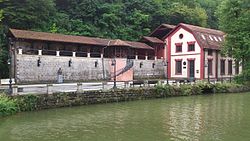
Hydropower has been used since ancient times to grind flour and perform other tasks. In the late 18th century hydraulic power provided the energy source needed for the start of the Industrial Revolution. In the mid-1700s, French engineer Bernard Forest de Bélidor published Architecture Hydraulique, which described vertical- and horizontal-axis hydraulic machines, and in 1771 Richard Arkwright's combination of water power, the water frame, and continuous production played a significant part in the development of the factory system, with modern employment practices. In the 1840s, hydraulic power networks were developed to generate and transmit hydro power to end users.
By the late 19th century, the electrical generator was developed and could now be coupled with hydraulics. The growing demand arising from the Industrial Revolution would drive development as well. In 1878, the world's first hydroelectric power scheme was developed at Cragside in Northumberland, England, by William Armstrong. It was used to power a single arc lamp in his art gallery. The old Schoelkopf Power Station No. 1, US, near Niagara Falls, began to produce electricity in 1881. The first Edison hydroelectric power station, the Vulcan Street Plant, began operating September 30, 1882, in Appleton, Wisconsin, with an output of about 12.5 kilowatts. By 1886 there were 45 hydroelectric power stations in the United States and Canada; and by 1889 there were 200 in the United States alone.
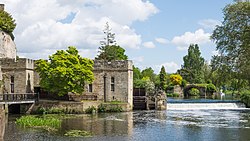
At the beginning of the 20th century, many small hydroelectric power stations were being constructed by commercial companies in mountains near metropolitan areas. Grenoble, France held the International Exhibition of Hydropower and Tourism, with over one million visitors 1925. By 1920, when 40% of the power produced in the United States was hydroelectric, the Federal Power Act was enacted into law. The Act created the Federal Power Commission to regulate hydroelectric power stations on federal land and water. As the power stations became larger, their associated dams developed additional purposes, including flood control, irrigation and navigation. Federal funding became necessary for large-scale development, and federally owned corporations, such as the Tennessee Valley Authority (1933) and the Bonneville Power Administration (1937) were created. Additionally, the Bureau of Reclamation which had begun a series of western US irrigation projects in the early 20th century, was now constructing large hydroelectric projects such as the 1928 Hoover Dam. The United States Army Corps of Engineers was also involved in hydroelectric development, completing the Bonneville Dam in 1937 and being recognized by the Flood Control Act of 1936 as the premier federal flood control agency.
Hydroelectric power stations continued to become larger throughout the 20th century. Hydropower was referred to as "white coal". Hoover Dam's initial 1,345 MW power station was the world's largest hydroelectric power station in 1936; it was eclipsed by the 6,809 MW Grand Coulee Dam in 1942. The Itaipu Dam opened in 1984 in South America as the largest, producing 14 GW, but was surpassed in 2008 by the Three Gorges Dam in China at 22.5 GW. Hydroelectricity would eventually supply some countries, including Norway, Democratic Republic of the Congo, Paraguay and Brazil, with over 85% of their electricity.
Future potential
In 2021 the International Energy Agency (IEA) said that more efforts are needed to help limit climate change. Some countries have highly developed their hydropower potential and have very little room for growth: Switzerland produces 88% of its potential and Mexico 80%. In 2022, the IEA released a main-case forecast of 141 GW generated by hydropower over 2022–2027, which is slightly lower than deployment achieved from 2017–2022. Because environmental permitting and construction times are long, they estimate hydropower potential will remain limited, with only an additional 40 GW deemed possible in the accelerated case.
Modernization of existing infrastructure
In 2021 the IEA said that major modernisation refurbishments are required.
Generating methods
Conventional (dams)
Most hydroelectric power comes from the potential energy of dammed water driving a water turbine and generator. The power extracted from the water depends on the volume and on the difference in height between the source and the water's outflow. This height difference is called the head. A large pipe (the "penstock") delivers water from the reservoir to the turbine.
Pumped-storage
This method produces electricity to supply high peak demands by moving water between reservoirs at different elevations. At times of low electrical demand, the excess generation capacity is used to pump water into the higher reservoir, thus providing demand side response. When the demand becomes greater, water is released back into the lower reservoir through a turbine. In 2021 pumped-storage schemes provided almost 85% of the world's 190 GW of grid energy storage and improve the daily capacity factor of the generation system. Pumped storage is not an energy source, and appears as a negative number in listings.
Run-of-the-river
Run-of-the-river hydroelectric stations are those with small or no reservoir capacity, so that only the water coming from upstream is available for generation at that moment, and any oversupply must pass unused. A constant supply of water from a lake or existing reservoir upstream is a significant advantage in choosing sites for run-of-the-river.
Tide
A tidal power station makes use of the daily rise and fall of ocean water due to tides; such sources are highly predictable, and if conditions permit construction of reservoirs, can also be dispatchable to generate power during high demand periods. Less common types of hydro schemes use water's kinetic energy or undammed sources such as undershot water wheels. Tidal power is viable in a relatively small number of locations around the world.
Sizes, types and capacities of hydroelectric facilities
The classification of hydropower plants starts with two top-level categories:
- small hydropower plants (SHP) and
- large hydropower plants (LHP).
The classification of a plant as an SHP or LHP is primarily based on its nameplate capacity, the threshold varies by the country, but in any case a plant with the capacity of 50 MW or more is considered an LHP. As an example, for China, SHP power is below 25 MW, for India - below 15 MW, most of Europe - below 10 MW.
The SHP and LHP categories are further subdivided into many subcategories that are not mutually exclusive. For example, a low-head hydro power plant with hydrostatic head of few meters to few tens of meters can be classified either as an SHP or an LHP. The other distinction between SHP and LHP is the degree of the water flow regulation: a typical SHP primarily uses the natural water discharge with very little regulation in comparison to an LHP. Therefore, the term SHP is frequently used as a synonym for the run-of-the-river power plant.
Large facilities
The largest power producers in the world are hydroelectric power stations, with some hydroelectric facilities capable of generating more than double the installed capacities of the current largest nuclear power stations.
Although no official definition exists for the capacity range of large hydroelectric power stations, facilities from over a few hundred megawatts are generally considered large hydroelectric facilities.
Currently, only seven facilities over 10 GW (10,000 MW) are in operation worldwide, see table below.
| Rank | Station | Country | Location | Capacity (MW) |
|---|---|---|---|---|
| 1. | Three Gorges Dam | 30°49′15″N 111°00′08″E / 30.82083°N 111.00222°E | 22,500 | |
| 2. | Baihetan Dam | 27°13′23″N 102°54′11″E / 27.22306°N 102.90306°E | 16,000 | |
| 3. | Itaipu Dam | 25°24′31″S 54°35′21″W / 25.40861°S 54.58917°W | 14,000 | |
| 4. | Xiluodu Dam | 28°15′35″N 103°38′58″E / 28.25972°N 103.64944°E | 13,860 | |
| 5. | Belo Monte Dam | 03°06′57″S 51°47′45″W / 3.11583°S 51.79583°W | 11,233 | |
| 6. | Guri Dam | 07°45′59″N 62°59′57″W / 7.76639°N 62.99917°W | 10,235 | |
| 7. | Wudongde Dam | 26°20′2″N 102°37′48″E / 26.33389°N 102.63000°E | 10,200 |
Small
Small hydro is hydroelectric power on a scale serving a small community or industrial plant. The definition of a small hydro project varies but a generating capacity of up to 10 megawatts (MW) is generally accepted as the upper limit. This may be stretched to 25 MW and 30 MW in Canada and the United States.
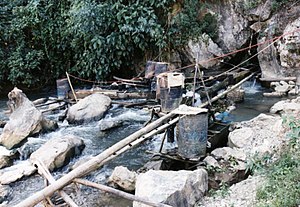
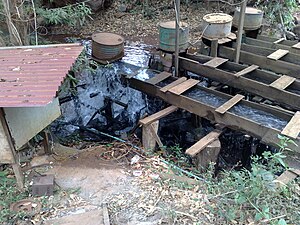
Small hydro stations may be connected to conventional electrical distribution networks as a source of low-cost renewable energy. Alternatively, small hydro projects may be built in isolated areas that would be uneconomic to serve from a grid, or in areas where there is no national electrical distribution network. Since small hydro projects usually have minimal reservoirs and civil construction work, they are seen as having a relatively low environmental impact compared to large hydro. This decreased environmental impact depends strongly on the balance between stream flow and power production.
Micro
Micro hydro means hydroelectric power installations that typically produce up to 100 kW of power. These installations can provide power to an isolated home or small community, or are sometimes connected to electric power networks. There are many of these installations around the world, particularly in developing nations as they can provide an economical source of energy without purchase of fuel. Micro hydro systems complement photovoltaic solar energy systems because in many areas water flow, and thus available hydro power, is highest in the winter when solar energy is at a minimum.
Pico
Pico hydro is hydroelectric power generation of under 5 kW. It is useful in small, remote communities that require only a small amount of electricity. For example, the 1.1 kW Intermediate Technology Development Group Pico Hydro Project in Kenya supplies 57 homes with very small electric loads (e.g., a couple of lights and a phone charger, or a small TV/radio). Even smaller turbines of 200–300 W may power a few homes in a developing country with a drop of only 1 m (3 ft). A Pico-hydro setup is typically run-of-the-river, meaning that dams are not used, but rather pipes divert some of the flow, drop this down a gradient, and through the turbine before returning it to the stream.
Underground
An underground power station is generally used at large facilities and makes use of a large natural height difference between two waterways, such as a waterfall or mountain lake. A tunnel is constructed to take water from the high reservoir to the generating hall built in a cavern near the lowest point of the water tunnel and a horizontal tailrace taking water away to the lower outlet waterway.
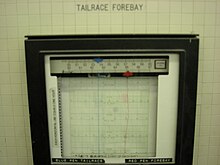
Calculating available power
A simple formula for approximating electric power production at a hydroelectric station is:
where
- is power (in watts)
- (eta) is the coefficient of efficiency (a unitless, scalar coefficient, ranging from 0 for completely inefficient to 1 for completely efficient).
- (rho) is the density of water (~1000 kg/m)
- is the volumetric flow rate (in m/s)
- is the mass flow rate (in kg/s)
- (Delta h) is the change in height (in meters)
- is acceleration due to gravity (9.8 m/s)
Efficiency is often higher (that is, closer to 1) with larger and more modern turbines. Annual electric energy production depends on the available water supply. In some installations, the water flow rate can vary by a factor of 10:1 over the course of a year.
Properties
Advantages
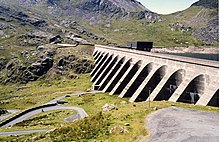
Flexibility
Hydropower is a flexible source of electricity since stations can be ramped up and down very quickly to adapt to changing energy demands. Hydro turbines have a start-up time of the order of a few minutes. Although battery power is quicker its capacity is tiny compared to hydro. It takes less than 10 minutes to bring most hydro units from cold start-up to full load; this is quicker than nuclear and almost all fossil fuel power. Power generation can also be decreased quickly when there is a surplus power generation. Hence the limited capacity of hydropower units is not generally used to produce base power except for vacating the flood pool or meeting downstream needs. Instead, it can serve as backup for non-hydro generators.
High value power
The major advantage of conventional hydroelectric dams with reservoirs is their ability to store water at low cost for dispatch later as high value clean electricity. In 2021, the IEA estimated that the "reservoirs of all existing conventional hydropower plants combined can store a total of 1,500 terawatt-hours (TWh) of electrical energy in one full cycle" which was "about 170 times more energy than the global fleet of pumped storage hydropower plants". Battery storage capacity is not expected to overtake pumped storage during the 2020s. When used as peak power to meet demand, hydroelectricity has a higher value than baseload power and a much higher value compared to intermittent energy sources such as wind and solar.
Hydroelectric stations have long economic lives, with some plants still in service after 50–100 years. Operating labor cost is also usually low, as plants are automated and have few personnel on site during normal operation.
Where a dam serves multiple purposes, a hydroelectric station may be added with relatively low construction cost, providing a useful revenue stream to offset the costs of dam operation. It has been calculated that the sale of electricity from the Three Gorges Dam will cover the construction costs after 5 to 8 years of full generation. However, some data shows that in most countries large hydropower dams will be too costly and take too long to build to deliver a positive risk adjusted return, unless appropriate risk management measures are put in place.
Suitability for industrial applications
While many hydroelectric projects supply public electricity networks, some are created to serve specific industrial enterprises. Dedicated hydroelectric projects are often built to provide the substantial amounts of electricity needed for aluminium electrolytic plants, for example. The Grand Coulee Dam switched to support Alcoa aluminium in Bellingham, Washington, United States for American World War II airplanes before it was allowed to provide irrigation and power to citizens (in addition to aluminium power) after the war. In Suriname, the Brokopondo Reservoir was constructed to provide electricity for the Alcoa aluminium industry. New Zealand's Manapouri Power Station was constructed to supply electricity to the aluminium smelter at Tiwai Point.
Reduced CO2 emissions
Since hydroelectric dams do not use fuel, power generation does not produce carbon dioxide. While carbon dioxide is initially produced during construction of the project, and some methane is given off annually by reservoirs, hydro has one of the lowest lifecycle greenhouse gas emissions for electricity generation. The low greenhouse gas impact of hydroelectricity is found especially in temperate climates. Greater greenhouse gas emission impacts are found in the tropical regions because the reservoirs of power stations in tropical regions produce a larger amount of methane than those in temperate areas.
Like other non-fossil fuel sources, hydropower also has no emissions of sulfur dioxide, nitrogen oxides, or other particulates.
Other uses of the reservoir
Reservoirs created by hydroelectric schemes often provide facilities for water sports, and become tourist attractions themselves. In some countries, aquaculture in reservoirs is common. Multi-use dams installed for irrigation support agriculture with a relatively constant water supply. Large hydro dams can control floods, which would otherwise affect people living downstream of the project. Managing dams which are also used for other purposes, such as irrigation, is complicated.
Disadvantages
In 2021 the IEA called for "robust sustainability standards for all hydropower development with streamlined rules and regulations".
Ecosystem damage and loss of land

Large reservoirs associated with traditional hydroelectric power stations result in submersion of extensive areas upstream of the dams, sometimes destroying biologically rich and productive lowland and riverine valley forests, marshland and grasslands. Damming interrupts the flow of rivers and can harm local ecosystems, and building large dams and reservoirs often involves displacing people and wildlife. The loss of land is often exacerbated by habitat fragmentation of surrounding areas caused by the reservoir.
Hydroelectric projects can be disruptive to surrounding aquatic ecosystems both upstream and downstream of the plant site. Generation of hydroelectric power changes the downstream river environment. Water exiting a turbine usually contains very little suspended sediment, which can lead to scouring of river beds and loss of riverbanks. The turbines also will kill large portions of the fauna passing through, for instance 70% of the eel passing a turbine will perish immediately. Since turbine gates are often opened intermittently, rapid or even daily fluctuations in river flow are observed.
Drought and water loss by evaporation
Drought and seasonal changes in rainfall can severely limit hydropower. Water may also be lost by evaporation.
Siltation and flow shortage
When water flows it has the ability to transport particles heavier than itself downstream. This has a negative effect on dams and subsequently their power stations, particularly those on rivers or within catchment areas with high siltation. Siltation can fill a reservoir and reduce its capacity to control floods along with causing additional horizontal pressure on the upstream portion of the dam. Eventually, some reservoirs can become full of sediment and useless or over-top during a flood and fail.
Changes in the amount of river flow will correlate with the amount of energy produced by a dam. Lower river flows will reduce the amount of live storage in a reservoir therefore reducing the amount of water that can be used for hydroelectricity. The result of diminished river flow can be power shortages in areas that depend heavily on hydroelectric power. The risk of flow shortage may increase as a result of climate change. One study from the Colorado River in the United States suggest that modest climate changes, such as an increase in temperature in 2 degree Celsius resulting in a 10% decline in precipitation, might reduce river run-off by up to 40%. Brazil in particular is vulnerable due to its heavy reliance on hydroelectricity, as increasing temperatures, lower water flow and alterations in the rainfall regime, could reduce total energy production by 7% annually by the end of the century.
Methane emissions (from reservoirs)
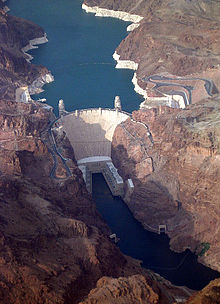
Lower positive impacts are found in the tropical regions. In lowland rainforest areas, where inundation of a part of the forest is necessary, it has been noted that the reservoirs of power plants produce substantial amounts of methane. This is due to plant material in flooded areas decaying in an anaerobic environment and forming methane, a greenhouse gas. According to the World Commission on Dams report, where the reservoir is large compared to the generating capacity (less than 100 watts per square metre of surface area) and no clearing of the forests in the area was undertaken prior to impoundment of the reservoir, greenhouse gas emissions from the reservoir may be higher than those of a conventional oil-fired thermal generation plant.
In boreal reservoirs of Canada and Northern Europe, however, greenhouse gas emissions are typically only 2% to 8% of any kind of conventional fossil-fuel thermal generation. A new class of underwater logging operation that targets drowned forests can mitigate the effect of forest decay.
Relocation
Another disadvantage of hydroelectric dams is the need to relocate the people living where the reservoirs are planned. In 2000, the World Commission on Dams estimated that dams had physically displaced 40–80 million people worldwide.
Failure risks
Because large conventional dammed-hydro facilities hold back large volumes of water, a failure due to poor construction, natural disasters or sabotage can be catastrophic to downriver settlements and infrastructure.
During Typhoon Nina in 1975 Banqiao Dam in Southern China failed when more than a year's worth of rain fell within 24 hours (see 1975 Banqiao Dam failure). The resulting flood resulted in the deaths of 26,000 people, and another 145,000 from epidemics. Millions were left homeless.
The creation of a dam in a geologically inappropriate location may cause disasters such as 1963 disaster at Vajont Dam in Italy, where almost 2,000 people died.
The Malpasset Dam failure in Fréjus on the French Riviera (Côte d'Azur), southern France, collapsed on December 2, 1959, killing 423 people in the resulting flood.
Smaller dams and micro hydro facilities create less risk, but can form continuing hazards even after being decommissioned. For example, the small earthen embankment Kelly Barnes Dam failed in 1977, twenty years after its power station was decommissioned, causing 39 deaths.
Comparison and interactions with other methods of power generation
This section needs to be updated. The reason given is: solar panels on reservoirs, also Tasmania link. (January 2022) |
Hydroelectricity eliminates the flue gas emissions from fossil fuel combustion, including pollutants such as sulfur dioxide, nitric oxide, carbon monoxide, dust, and mercury in the coal. Hydroelectricity also avoids the hazards of coal mining and the indirect health effects of coal emissions. In 2021 the IEA said that government energy policy should "price in the value of the multiple public benefits provided by hydropower plants".
Nuclear power
Nuclear power is relatively inflexible; although it can reduce its output reasonably quickly. Since the cost of nuclear power is dominated by its high infrastructure costs, the cost per unit energy goes up significantly with low production. Because of this, nuclear power is mostly used for baseload. By way of contrast, hydroelectricity can supply peak power at much lower cost. Hydroelectricity is thus often used to complement nuclear or other sources for load following. Country examples where they are paired in a close to 50/50 share include the electric grid in Switzerland, the Electricity sector in Sweden and to a lesser extent, Ukraine and the Electricity sector in Finland.
Wind power
Wind power goes through predictable variation by season, but is intermittent on a daily basis. Maximum wind generation has little relationship to peak daily electricity consumption, the wind may peak at night when power is not needed or be still during the day when electrical demand is highest. Occasionally weather patterns can result in low wind for days or weeks at a time, a hydroelectric reservoir capable of storing weeks of output is useful to balance generation on the grid. Peak wind power can be offset by minimum hydropower and minimum wind can be offset with maximum hydropower. In this way the easily regulated character of hydroelectricity is used to compensate for the intermittent nature of wind power. Conversely, in some cases wind power can be used to spare water for later use in dry seasons.
An example of this is Norway's trading with Sweden, Denmark, the Netherlands, Germany and the UK. Norway is 98% hydropower, while its flatland neighbors have wind power. In areas that do not have hydropower, pumped storage serves a similar role, but at a much higher cost and 20% lower efficiency.
Hydro power by country



In 2022, hydro generated 4,289 TWh, 15% of total electricity and half of renewables. Of the world total, China (30%) produced the most, followed by Brazil (10%), Canada (9.2%), the United States (5.8%) and Russia (4.6%).
Paraguay produces nearly all of its electricity from hydro and exports far more than it uses. Larger plants tend to be built and operated by national governments, so most capacity (70%) is publicly owned, despite the fact that most plants (nearly 70%) are owned and operated by the private sector, as of 2021.
The following table lists these data for each country:
- total generation from hydro in terawatt-hours,
- percent of that country's generation that was hydro,
- total hydro capacity in gigawatts,
- percent growth in hydro capacity, and
- the hydro capacity factor for that year.
Data are sourced from Ember dating to the year 2023 unless otherwise specified. Only includes countries with more than 1 TWh of generation. Links for each location go to the relevant hydro power page, when available.
| Country | Gen (TWh) |
% gen. |
Cap. (GW) |
% cap. growth |
Cap. fac. |
|---|---|---|---|---|---|
| World | 4183.41 | 14.2 | 1267.90 | 0.6 | 38% |
| 1226.00 | 13.0 | 370.60 | 0.8 | 38% | |
| 428.65 | 60.4 | 109.90 | 0.1 | 50% | |
| 364.20 | 57.5 | 83.31 | 0.0 | 50% | |
| 233.96 | 5.5 | 86.66 | 0.0 | 31% | |
| 200.87 | 17.1 | 50.57 | -1.6 | 45% | |
| 149.17 | 7.6 | 47.33 | 0.2 | 36% | |
| 135.96 | 88.5 | 34.40 | 0.4 | 45% | |
| 80.90 | 29.3 | 22.64 | 0.5 | 41% | |
| 74.50 | 7.4 | 28.22 | 0.1 | 30% | |
| 66.07 | 39.7 | 16.40 | 0.0 | 46% | |
| 65.68 | 77.6 | 16.81 | 0.0 | 45% | |
| 63.72 | 19.9 | 31.78 | 0.7 | 23% | |
| 54.24 | 62.5 | 13.21 | 5.3 | 47% | |
| 53.19 | 10.4 | 24.14 | -0.4 | 25% | |
| 43.87 | 99.7 | 8.81 | 0.0 | 57% | |
| 39.79 | 59.4 | 14.71 | -1.4 | 31% | |
| 39.00 | 54.8 | 15.28 | 1.4 | 29% | |
| 37.94 | 14.5 | 18.85 | -0.4 | 23% | |
| 37.90 | 23.5 | 10.64 | 0.0 | 41% | |
| 33.40 | 72.7 | 9.65 | 7.7 | 40% | |
| 31.51 | 16.8 | 6.21 | 0.0 | 58% | |
| 31.51 | 52.6 | 5.50 | 0.0 | 65% | |
| 29.90 | 20.4 | 10.39 | 0.0 | 33% | |
| 26.61 | 76.4 | 5.19 | 0.0 | 59% | |
| 26.04 | 58.5 | 5.68 | 0.0 | 52% | |
| 24.59 | 7.0 | 6.78 | 1.3 | 41% | |
| 23.90 | 28.6 | 7.47 | 2.5 | 37% | |
| 22.65 | 5.9 | 11.68 | 1.6 | 22% | |
| 20.40 | 5.8 | 13.30 | 0.0 | 18% | |
| 20.01 | 7.4 | 16.81 | 0.0 | 14% | |
| 19.47 | 3.9 | 5.74 | 2.1 | 39% | |
| 18.66 | 89.4 | 5.76 | 0.3 | 37% | |
| 18.30 | 32.5 | 6.57 | 0.0 | 32% | |
| 17.09 | 87.8 | 3.17 | 17.0 | 62% | |
| 15.49 | 81.4 | 2.19 | 0.0 | 81% | |
| 15.26 | 5.6 | 8.44 | 9.5 | 21% | |
| 15.11 | 18.9 | 3.18 | 0.3 | 54% | |
| 14.75 | 95.7 | 4.82 | 18.4 | 35% | |
| 13.94 | 70.2 | 2.11 | 0.0 | 75% | |
| 13.82 | 6.3 | 2.83 | 0.0 | 56% | |
| 12.82 | 57.5 | 4.89 | 0.6 | 30% | |
| 12.64 | 74.6 | 3.73 | 0.0 | 39% | |
| 12.19 | 32.0 | 2.49 | 0.0 | 56% | |
| 11.90 | 85.9 | 2.78 | 0.0 | 49% | |
| 11.10 | 9.9 | 4.82 | 0.0 | 26% | |
| 11.00 | 99.6 | 2.93 | 12.3 | 43% | |
| 11.00 | 61.6 | 1.48 | 0.0 | 85% | |
| 10.98 | 24.5 | 8.19 | 0.0 | 15% | |
| 10.85 | 75.5 | 3.45 | 2.1 | 36% | |
| 9.67 | 98.5 | 2.20 | 11.7 | 50% | |
| 9.37 | 51.6 | 3.27 | 0.0 | 33% | |
| 9.24 | 69.2 | 1.84 | 1.7 | 57% | |
| 9.08 | 7.7 | 3.09 | 1.6 | 34% | |
| 9.00 | 100.0 | 2.33 | 0.0 | 44% | |
| 8.79 | 7.8 | 2.90 | 3.2 | 35% | |
| 8.45 | 70.5 | 2.37 | 1.7 | 41% | |
| 8.28 | 20.4 | 2.85 | 32.6 | 33% | |
| 7.87 | 46.5 | 2.21 | 0.0 | 41% | |
| 7.50 | 33.3 | 1.58 | 0.0 | 54% | |
| 6.96 | 99.4 | 2.49 | -0.8 | 32% | |
| 6.59 | 3.5 | 3.11 | 0.0 | 24% | |
| 6.37 | 37.4 | 1.84 | 0.0 | 40% | |
| 5.88 | 65.9 | 1.08 | 0.0 | 62% | |
| 5.19 | 1.8 | 2.19 | 0.0 | 27% | |
| 5.11 | 29.4 | 1.83 | 1.7 | 32% | |
| 5.08 | 38.6 | 1.57 | 0.0 | 37% | |
| 5.00 | 61.6 | 0.81 | 0.0 | 70% | |
| 4.97 | 6.7 | 2.23 | 8.8 | 25% | |
| 4.96 | 32.6 | 1.16 | -0.9 | 49% | |
| 4.81 | 89.2 | 1.03 | 2.0 | 53% | |
| 4.63 | 15.6 | 1.62 | 0.0 | 33% | |
| 4.00 | 45.4 | 1.68 | 26.3 | 27% | |
| 4.00 | 33.3 | 0.91 | 7.1 | 50% | |
| 3.96 | 1.4 | 2.10 | 0.0 | 22% | |
| 3.87 | 7.8 | 3.43 | 0.3 | 13% | |
| 3.80 | 60.8 | 1.57 | -1.3 | 28% | |
| 3.72 | 0.6 | 1.80 | -0.6 | 24% | |
| 3.62 | 27.4 | 1.54 | 0.0 | 27% | |
| 3.35 | 30.1 | 0.88 | 0.0 | 43% | |
| 3.11 | 7.8 | 2.53 | 0.0 | 14% | |
| 2.82 | 31.3 | 0.60 | 1.7 | 54% | |
| 2.70 | 22.1 | 0.86 | 0.0 | 36% | |
| 2.65 | 2.3 | 1.56 | 0.0 | 19% | |
| 2.38 | 1.4 | 0.98 | 0.0 | 28% | |
| 2.34 | 3.1 | 1.12 | 0.9 | 24% | |
| 2.31 | 19.0 | 0.74 | 0.0 | 36% | |
| 2.13 | 52.1 | 0.70 | 0.0 | 35% | |
| 2.00 | 22.8 | 1.35 | 0.0 | 17% | |
| 2.00 | 65.8 | 0.81 | 37.3 | 28% | |
| 1.69 | 0.7 | 0.75 | 0.0 | 26% | |
| 1.65 | 23.5 | 0.70 | 0.0 | 27% | |
| 1.62 | 21.8 | 0.57 | 0.0 | 32% | |
| 1.60 | 5.5 | 1.16 | 0.0 | 16% | |
| 1.40 | 37.3 | 0.46 | 43.8 | 35% | |
| 1.05 | 77.8 | 0.39 | 0.0 | 31% | |
| 1.00 | 4.6 | 0.62 | 0.0 | 18% |
Economics
The weighted average cost of capital is a major factor.
See also
- Energy transition
- Hydraulic engineering
- International Hydropower Association
- International Rivers
- List of energy storage power plants
- List of hydroelectric power station failures
- List of largest power stations
- List of renewable energy topics by country and territory
- Lists of hydroelectric power stations
- Marine current power – electricity from sea currents
- National Hydropower Association (US)
References
- ^ "Global Electricity Review 2024". Ember. 2024-05-07. Retrieved 2024-09-02.
- ^ "Hydropower Special Market Report – Analysis". IEA. 30 June 2021. Retrieved 2022-01-30.
- ^ Renewables 2011 Global Status Report, page 25, Hydropower, REN21, published 2011, accessed 2016-02-19.
- ^ de Faria, Felipe A M; Jaramillo, Paulina; Sawakuchi, Henrique O; Richey, Jeffrey E; Barros, Nathan (2015-12-01). "Estimating greenhouse gas emissions from future Amazonian hydroelectric reservoirs". Environmental Research Letters. 10 (12): 124019. Bibcode:2015ERL....10l4019D. doi:10.1088/1748-9326/10/12/124019. ISSN 1748-9326.
- ^ Fearnside, Philip M. (1989-07-01). "Brazil's Balbina Dam: Environment versus the legacy of the Pharaohs in Amazonia". Environmental Management. 13 (4): 401–423. Bibcode:1989EnMan..13..401F. doi:10.1007/BF01867675. ISSN 1432-1009. S2CID 154405904.
- ^ Yardley, Jim (2007-11-19). "Chinese Dam Projects Criticized for Their Human Costs". The New York Times. ISSN 0362-4331. Archived from the original on April 21, 2023. Retrieved 2023-04-21.
- ^ December 2022, "Renewables 2022", IEA, Paris, license: CC BY 4.0.
- ^ "BP Statistical Review of World Energy 2019" (PDF). BP. Retrieved 28 March 2020.
- ^ "Large hydropower dams not sustainable in the developing world". BBC News. 5 November 2018. Retrieved 27 March 2020.
- ^ "Hydroelectricity". IEA – International Energy Agency. 28 April 2024.
- ^ One of the Oldest Hydroelectric Power Plants in Europa Built on Tesla's Principels, Explorations in the History of Machines and Mechanisms: Proceedings of HMM2012, Teun Koetsier and Marco Ceccarelli, 2012.
- ^ Maxine Berg, The age of manufactures, 1700-1820: Industry, innovation and work in Britain (Routledge, 2005).
- ^ "History of Hydropower". U.S. Department of Energy.
- ^ "Hydroelectric Power". Water Encyclopedia.
- ^ Association for Industrial Archaeology (1987). Industrial archaeology review, Volumes 10-11. Oxford University Press. p. 187.
- ^ "Hydroelectric power - energy from falling water". Clara.net.
- ^ "Boulder Canyon Project Act" (PDF). December 21, 1928. Archived from the original (PDF) on June 13, 2011.
- ^ The Evolution of the Flood Control Act of 1936, Joseph L. Arnold, United States Army Corps of Engineers, 1988 Archived 2007-08-23 at the Wayback Machine
- ^ "Hydropower". The Book of Knowledge. Vol. 9 (1945 ed.). p. 3220.
- ^ "Hoover Dam and Lake Mead". U.S. Bureau of Reclamation.
- ^ "Hydropower – Analysis". IEA. Retrieved 2022-01-30.
- ^ "Renewable Energy Essentials: Hydropower" (PDF). IEA.org. International Energy Agency. Archived from the original (PDF) on 2017-03-29. Retrieved 2017-01-16.
- ^ "Hydroelectricity - Renewable Energy Generation". www.electricityforum.com.
- ^ "Pumped Storage, Explained". Archived from the original on December 31, 2012.
- ^ "Run-of-the-River Hydropower Goes With the Flow". 31 January 2012.
- ^ "Energy Resources: Tidal power". www.darvill.clara.net.
- ^ Kuriqi & Jurasz 2022, pp. 505–506.
- ^ Kuriqi & Jurasz 2022, p. 505.
- ^ Nelson, V.C. (2011). Introduction to Renewable Energy. Taylor & Francis. p. 246. ISBN 978-1-4398-3450-3. Retrieved 2024-04-27.
- ^ Kuriqi & Jurasz 2022, p. 506.
- ^ Hemanth Kumar (March 2021). "World's biggest hydroelectric power plants". Retrieved 2022-02-05.
- ^ Pope, Gregory T. (December 1995), "The seven wonders of the modern world", Popular Mechanics, pp. 48–56
- ^ Renewables Global Status Report 2006 Update Archived July 18, 2011, at the Wayback Machine, REN21, published 2006
- ^ Renewables Global Status Report 2009 Update Archived July 18, 2011, at the Wayback Machine, REN21, published 2009
- ^ "Micro Hydro in the fight against poverty". Tve.org. Archived from the original on 2012-04-26. Retrieved 2012-07-22.
- ^ "Pico Hydro Power". T4cd.org. Archived from the original on 2009-07-31. Retrieved 2010-07-16.
- ^ Robert A. Huggins (1 September 2010). Energy Storage. Springer. p. 60. ISBN 978-1-4419-1023-3.
- ^ "About 25% of U.S. power plants can start up within an hour - Today in Energy - U.S. Energy Information Administration (EIA)". www.eia.gov. Retrieved 2022-01-30.
- ^ Bent Sørensen (2004). Renewable Energy: Its Physics, Engineering, Use, Environmental Impacts, Economy, and Planning Aspects. Academic Press. pp. 556–. ISBN 978-0-12-656153-1.
- ^ Geological Survey (U.S.) (1980). Geological Survey Professional Paper. U.S. Government Printing Office. p. 10.
- ^ Hydropower – A Way of Becoming Independent of Fossil Energy? Archived 28 May 2008 at the Wayback Machine
- ^ "Beyond Three Gorges in China". Waterpowermagazine.com. 2007-01-10. Archived from the original on 2011-06-14.
- ^ Ansar, Atif; Flyvbjerg, Bent; Budzier, Alexander; Lunn, Daniel (March 2014). "Should We Build More Large Dams? The Actual Costs of Hydropower Megaproject Development". Energy Policy. 69: 43–56. arXiv:1409.0002. Bibcode:2014EnPol..69...43A. doi:10.1016/j.enpol.2013.10.069. S2CID 55722535. SSRN 2406852.
- ^ "2018 Hydropower Status Report: Sector Trends and Insights" (PDF). International Hydropower Association. 2018. p. 16. Retrieved 19 March 2022.
- ^ Wehrli, Bernhard (1 September 2011). "Climate science: Renewable but not carbon-free". Nature Geoscience. 4 (9): 585–586. Bibcode:2011NatGe...4..585W. doi:10.1038/ngeo1226.
- ^ Atkins, William (2003). "Hydroelectric Power". Water: Science and Issues. 2: 187–191.
- ^ Robbins, Paul (2007). "Hydropower". Encyclopedia of Environment and Society. 3.
- ^ "Sedimentation Problems with Dams". Internationalrivers.org. Archived from the original on 2010-10-01. Retrieved 2010-07-16.
- ^ "Loss of European silver eel passing a hydropower station | Request PDF".
- ^ "One in five fish dies from passing hydroelectric turbines".
- ^ "Another nail in the coffin for endangered eels". 26 August 2019.
- ^ Glowa, Sarah E.; Kneale, Andrea J.; Watkinson, Douglas A.; Ghamry, Haitham K.; Enders, Eva C.; Jardine, Timothy D. (10 February 2023). "Applying a 2D-Hydrodynamic Model to Estimate Fish Stranding Risk Downstream from a Hydropeaking Hydroelectric Station". Ecohydrology. E2530. doi:10.1002/eco.2530. hdl:10388/14866. S2CID 256818410.
- ^ John Macknick and others, A Review of Operational Water Consumption and Withdrawal Factors for Electricity Generating Technologies, National Renewable Energy Laboratory, Technical Report NREL/TP-6A20-50900.
- ^ Patrick James, H Chansen (1998). "Teaching Case Studies in Reservoir Siltation and Catchment Erosion" (PDF). Great Britain: TEMPUS Publications. pp. 265–275. Archived from the original (PDF) on 2009-09-02.
- ^ Șentürk, Fuat (1994). Hydraulics of dams and reservoirs (reference. ed.). Highlands Ranch, Colo.: Water Resources Publications. p. 375. ISBN 0-918334-80-2.
- ^ Frauke Urban and Tom Mitchell 2011. Climate change, disasters and electricity generation Archived September 20, 2012, at the Wayback Machine. London: Overseas Development Institute and Institute of Development Studies
- ^ "Deliberate drowning of Brazil's rainforest is worsening climate change", Daniel Grossman 18 September 2019, New Scientist; retrieved 30 September 2020
- ^ "WCD Findal Report". Dams.org. 2000-11-16. Archived from the original on 2013-08-21.
- ^ Graham-Rowe, Duncan (24 February 2005). "Hydroelectric power's dirty secret revealed". NewScientist.com.
- ^ ""Rediscovered" Wood & The Triton Sawfish". Inhabitat. 2006-11-16.
- ^ "Briefing of World Commission on Dams". Internationalrivers.org. 2008-02-29. Archived from the original on 2008-09-13. Retrieved 2008-09-03.
- ^ References may be found in the list of Dam failures.
- ^ Bruel, Frank. "La catastrophe de Malpasset en 1959". Retrieved 2 September 2015.
- ^ Toccoa Flood USGS Historical Site, retrieved 02sep2009
- ^ "Norway is Europe's cheapest "battery"". SINTEF.no. 18 December 2014.
- ^ "Germany and Norway commission NordLink power cable". Power Technology. 2021-05-28. Retrieved 2022-01-29.
- ^ "Share of electricity production from hydropower". Our World in Data. Retrieved 20 June 2024.
- ^ "Yearly electricity data". ember-climate.org. 6 Dec 2023. Retrieved 20 August 2024.
- ^ "Paraguay: a significant electricity exporter, but citizens suffer outages". Dialogo China. 14 Jun 2022. Retrieved 30 Dec 2023.
Sources
- Kuriqi, Alban; Jurasz, Jakub (2022). "Small hydropower plants proliferation and fluvial ecosystem conservation nexus". Complementarity of Variable Renewable Energy Sources. Elsevier. doi:10.1016/b978-0-323-85527-3.00027-3. ISBN 978-0-323-85527-3.
External links
- Hydropower Reform Coalition
- Interactive demonstration on the effects of dams on rivers Archived 2019-07-25 at the Wayback Machine
- European Small Hydropower Association
- IEC TC 4: Hydraulic turbines (International Electrotechnical Commission - Technical Committee 4) IEC TC 4 portal with access to scope, documents and TC 4 website Archived 2015-04-27 at the Wayback Machine









